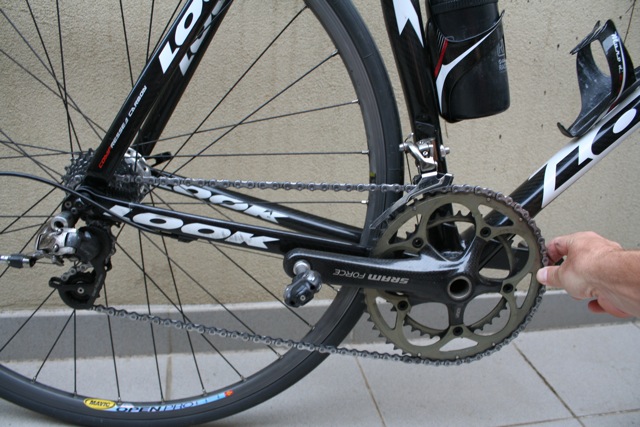One of the most common drivetrain problems is ‘chain skip’. This is when your chain slips forward while pedaling under pressure. There could be a few problems that are causing this. Sometimes a stiff chainlink causes this, and other times a worn freehub body. A very common problem is a worn chain. Chains will ’stretch’ over time (It’s not stretch actually. The pins that join the links together wear and turn into a “D” shape extending the pitch of the chain). This ‘stretch’ is actually the pins and bushings starting to wear which causes them to start skipping. Once your chain wears, the cassette and chainrings start to wear along with it. If you replace your chain before it starts to wear too badly it will dramatically increase the life of the rest of your drivetrain (cassette and chainrings). A $50 new chain every few months could save you hundreds by preserving your drivetrain.
You could go out and buy a chain measurement tool, but who has the time and $10 to do that??? A much easier way is to do the following:
1. Shift gears so that your chain is in the big ring and smallest gear on the cassette (i.e. 53-11T):

2. Pull at the chain at the front of the chainring as shown below. If the chain starts to lift off the top and/or the bottom of where it sits on the chainring teeth, this means that the chain is starting to wear. This ‘lift’ is because of the stretched chain not sitting properly in the teeth anymore. Unfortunately (well, fortunately) my chain isn’t worn so I can’t show you what a worn chain looks like when you pull on it. Trust me, you’ll know when you see it.

Measuring the Chain
Once you’ve determined that your chain is worn, it’s time to check to see how worn it is. If it starts to ‘lift’ on the chainring as described above, you’ll probably need to change it.
An even more accurate way to measure your chain is to do the following: With your chain still on the bike, place the ruler’s zero inch mark directly above the center of one of your chain pins. Now count 12 complete links. A complete link equals 1 inner and 1 outer. A rivet on a new chain should line up exactly to 12 inches on the ruler.

As a general rule (taken from bicycletutor.com), if the rivet is less than 1/16″ past the mark, your chain is ok. If it’s between 1/16″ and 1/8″ past the mark you’ll likely need a new chain, but your sprockets should be ok. If it’s more than 1/8″ past the mark, you’ll probably have to replace both the chain and cassette.
Worn Chainrings
Your front chainrings generally won’t need replacing very often. If worn they are very easy to spot, as they’ll start looking like shark teeth.

TIP Of The Day: Change your chain at the point of when it just starts to ‘lift’ off the chainring as described above and you’ll get years out of your drivetrain. Let your chain wear for too long and you’ll be left with up to $1000 in repairs (if you have Super Record 11)
